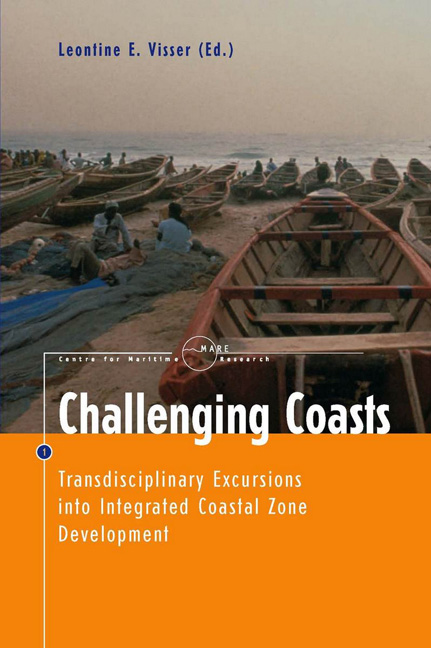Book contents
- Frontmatter
- Series Foreword
- Contents
- Acknowledgments
- 1 Introduction
- 2 Reflections on Transdisciplinarity, Integrated Coastal Development, and Governance
- 3 Biodiversity and the Natural Resource Management of Coral Reefs in Southeast Asia
- 4 A Concerted Approach towards Managing Living Resources in a Marine Protected Area
- 5 ‘Making Do’: Integrating Ecological and Societal Considerations for Marine Conservation in a Situation of Indigenous Resource Tenure
- 6 Basic Principles Underlying Research Projects on the Links between the Ecology and the Uses of Coral Reef Fishes in the Pacific
- 7 The Marine Implementation of the EC Birds and Habitats Directives: the Cases of Shipping and Oil Exploration Compared
- 8 Stakeholder Conflicts and Solutions across Political Scales: the Ibiraquera Lagoon, Brazil
- 9 ‘The Rich Eat Fish and the Poor Eat Pork’: The Decline of the Livelihoods of Handpickers of Aquatic Organisms in North Vietnam
- Index
- List of Contributors
4 - A Concerted Approach towards Managing Living Resources in a Marine Protected Area
Published online by Cambridge University Press: 28 January 2021
- Frontmatter
- Series Foreword
- Contents
- Acknowledgments
- 1 Introduction
- 2 Reflections on Transdisciplinarity, Integrated Coastal Development, and Governance
- 3 Biodiversity and the Natural Resource Management of Coral Reefs in Southeast Asia
- 4 A Concerted Approach towards Managing Living Resources in a Marine Protected Area
- 5 ‘Making Do’: Integrating Ecological and Societal Considerations for Marine Conservation in a Situation of Indigenous Resource Tenure
- 6 Basic Principles Underlying Research Projects on the Links between the Ecology and the Uses of Coral Reef Fishes in the Pacific
- 7 The Marine Implementation of the EC Birds and Habitats Directives: the Cases of Shipping and Oil Exploration Compared
- 8 Stakeholder Conflicts and Solutions across Political Scales: the Ibiraquera Lagoon, Brazil
- 9 ‘The Rich Eat Fish and the Poor Eat Pork’: The Decline of the Livelihoods of Handpickers of Aquatic Organisms in North Vietnam
- Index
- List of Contributors
Summary
Introduction
Managing a national park of international repute does not mean only preserving its landscape, fauna, and flora in as pristine a state as possible but also comprises the difficult task of reconciling this approach with sometimes very ancient uses of the land and resources. In the case of the Parc national du Banc d’Arguin in the West African state of Mauritania the permanent presence of populations within the limits of the park was ignored for many years until conflicts arose, forcing the park's authorities and their closest partners to rethink their management strategies.
The evolution of fishing practices of the Imraguen population offers a good example of such a conflict. Within the interval of a few years, internal and external pressures enticed Imraguen fishermen to shift from traditional fishing for yellow mullets to other species and to the use of more destructive gears, creating at the same time ecological and social problems. In this paper, we give first a quick overview of the geographical and historical contexts. We summarise the legal framework, the evolution of fishing practices as observed over the last two decades, and the many perverse consequences of these changes in fishing. We then describe how the park's authorities reacted, albeit belatedly, and explain the various steps taken to establish an open dialogue with the main stakeholders so that mutually beneficial solutions could be devised and agreed upon by all parties involved.
Historical Overview
The Banc d’Arguin National Park (PNBA) was established in 1976 by Presidential Decree, following active lobbying by international scientists to protect what had been identified as an exceptional wintering habitat for millions of palearctic migrating waders. Located north of Mauritania, between 19°21 and 20°50 N, the PNBA covers 12,000 km of desert, coastal and marine areas. It is the largest marine protected area of Africa.
Birds constitute only the most visible expression of the Banc d’Arguin's amazing biological diversity. From benthic organisms in the mud flats and seagrass areas through to shellfish, fish, marine mammals, and sea turtles, this area offers a cornucopia of marine life which has attracted all sorts of predators including humans.
- Type
- Chapter
- Information
- Challenging CoastsTransdisciplinary Excursions into Integrated Coastal Zone Development, pp. 73 - 92Publisher: Amsterdam University PressPrint publication year: 2004



